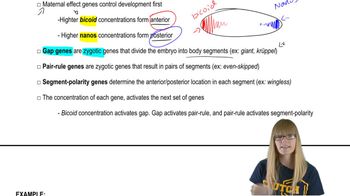Distinguish between the syncytial blastoderm stage and the cellular blastoderm stage in Drosophila embryogenesis.
Table of contents
- 1. Introduction to Genetics51m
- 2. Mendel's Laws of Inheritance3h 37m
- 3. Extensions to Mendelian Inheritance2h 41m
- 4. Genetic Mapping and Linkage2h 28m
- 5. Genetics of Bacteria and Viruses1h 21m
- 6. Chromosomal Variation1h 48m
- 7. DNA and Chromosome Structure56m
- 8. DNA Replication1h 10m
- 9. Mitosis and Meiosis1h 34m
- 10. Transcription1h 0m
- 11. Translation58m
- 12. Gene Regulation in Prokaryotes1h 19m
- 13. Gene Regulation in Eukaryotes44m
- 14. Genetic Control of Development44m
- 15. Genomes and Genomics1h 50m
- 16. Transposable Elements47m
- 17. Mutation, Repair, and Recombination1h 6m
- 18. Molecular Genetic Tools19m
- 19. Cancer Genetics29m
- 20. Quantitative Genetics1h 26m
- 21. Population Genetics50m
- 22. Evolutionary Genetics29m
14. Genetic Control of Development
Early Developmental Steps
Problem 10a
Textbook Question
Ablation of the anchor cell in wild-type C. elegans results in a vulva-less phenotype.
What phenotype is to be expected if the anchor cell is ablated in a let-23 loss-of-function mutant?
 Verified step by step guidance
Verified step by step guidance1
Understand the role of the anchor cell in C. elegans development: The anchor cell is crucial for inducing vulval development by signaling to the vulval precursor cells (VPCs) through the epidermal growth factor (EGF) signaling pathway.
Recognize the role of the let-23 gene: The let-23 gene encodes the EGF receptor, which is essential for receiving the signal from the anchor cell. A loss-of-function mutation in let-23 disrupts this signaling pathway, leading to a vulva-less phenotype even in the presence of the anchor cell.
Consider the effect of anchor cell ablation in a wild-type organism: Ablating the anchor cell in a wild-type organism prevents the signaling required for vulval development, resulting in a vulva-less phenotype.
Analyze the let-23 loss-of-function mutant with anchor cell ablation: In a let-23 loss-of-function mutant, the signaling pathway is already non-functional. Ablating the anchor cell does not change the outcome because the mutant is already incapable of responding to the signal.
Conclude the expected phenotype: The phenotype of the let-23 loss-of-function mutant with anchor cell ablation will remain vulva-less, as the signaling pathway is disrupted regardless of the presence or absence of the anchor cell.
 Verified video answer for a similar problem:
Verified video answer for a similar problem:This video solution was recommended by our tutors as helpful for the problem above
Video duration:
2mPlay a video:
Was this helpful?
Key Concepts
Here are the essential concepts you must grasp in order to answer the question correctly.
Anchor Cell Function
The anchor cell in C. elegans plays a crucial role in vulval development by signaling to surrounding cells to induce vulva formation. It releases signals that activate the vulval precursor cells, leading to the proper development of the vulva. Ablation of the anchor cell disrupts this signaling, resulting in a vulva-less phenotype.
Recommended video:
Guided course

Functional Genomics
let-23 Gene and Its Role
The let-23 gene encodes a receptor that is essential for the vulval induction process in C. elegans. It is part of the epidermal growth factor (EGF) signaling pathway, which mediates the response of vulval precursor cells to signals from the anchor cell. A loss-of-function mutation in let-23 impairs this signaling, preventing the normal development of the vulva.
Recommended video:
Guided course

Segmentation Genes
Phenotypic Outcomes of Genetic Mutations
Phenotypic outcomes in genetics refer to the observable traits resulting from the interaction of an organism's genotype with its environment. In the case of a let-23 loss-of-function mutant, the expected phenotype upon anchor cell ablation would likely be a vulva-less phenotype as well, since the signaling pathway necessary for vulval development is already compromised by the mutation.
Recommended video:
Guided course

Mutations and Phenotypes

 3:46m
3:46mWatch next
Master Drosophilia Development with a bite sized video explanation from Kylia
Start learningRelated Videos
Related Practice
Textbook Question
641
views
